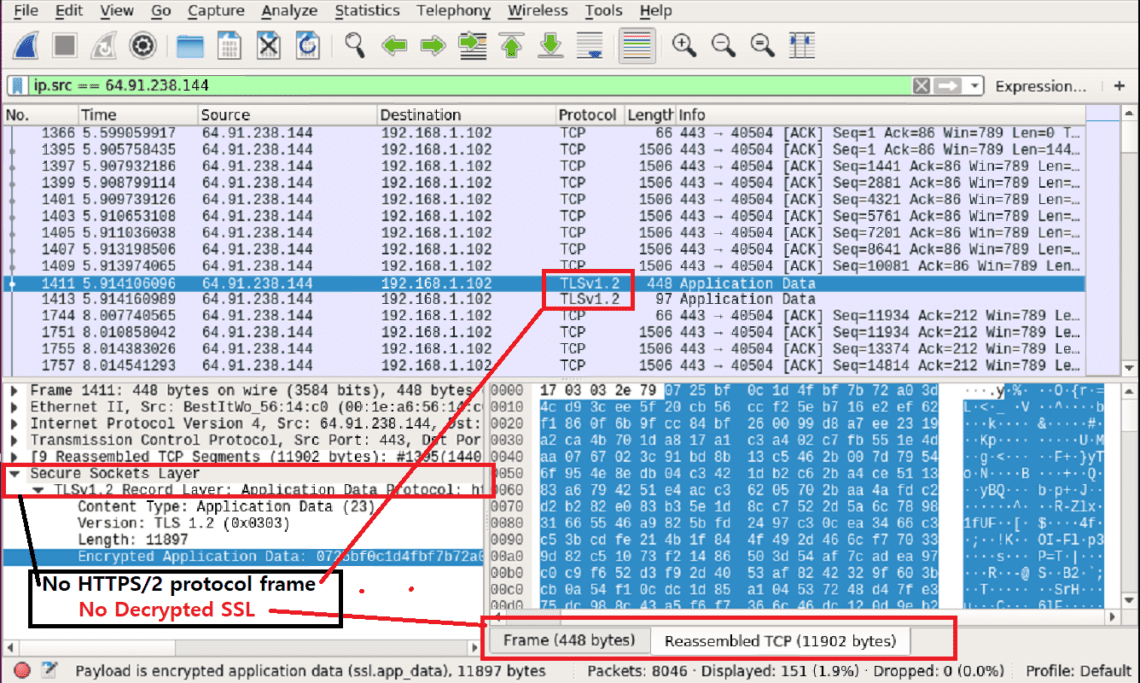

- #Wireshark decrypt tls 1.2 for free#
- #Wireshark decrypt tls 1.2 upgrade#
- #Wireshark decrypt tls 1.2 code#
Then, in 1999, the first version of TLS (1.0) was released as an upgrade to SSL 3.0. Although SSL 2.0 was publicly released, it also contained security flaws and was quickly replaced by SSL 3.0 in 1996. SSL 2.0 was first released in February 1995 (SSL 1.0 was never publicly released because of security flaws). It fixes some security vulnerabilities in the earlier SSL protocols. TLS is actually just a more recent version of SSL (Secure Sockets Layer). Usually, in server-to-server communication two-way SSL is being used.
#Wireshark decrypt tls 1.2 code#
The ability to turn your coffee into code is a plus ☕.Wireshark (for understanding the TLS handshake).I would love to give credit to Jonathon McKinney. If you go back and check the SSLkeylogfile.txt file, you will see a nice surprise inside. As you can see, it’s still encrypted.īut, if you click the “Decrypted SSL” tab at the bottom of the pane, the information will now be decrypted for you to see:Īs you can see now, all the https traffic is decrypted. You should see a lot of http traffic popping up on Wireshark now. Open up a new Window using Google Chrome and navigate to a Web site that uses https.

Since we’re now logging the SSL keys and exporting them into the SSLkeylogfile.txt file, Wireshark will collect these keys and decrypt the https traffic into http traffic. Type the filter “http” in the filter bar. Now, let’s start capturing traffic again using Wireshark.

Under the Protocols drop down list, click on “SSL.” Under the “(Pre)-Master-Secret log filename, you will post the path for the. Press Ctrl + Shift +P to open the Preferences box. Then, post the path to the SSLkeylogfile.txt file. Type “SSLKEYLOGFILE” in the variable name bar. Name your text document “SSLkeylogfile.txt.” Now, go back to the Environmental Variables box and click the “New” button at the bottom pane. Now, click on the “Environmental Variables…” box. However, if we navigate to Control Panel > System and Security > System, you will see the following:Ĭlick on the “Advanced systems settings” option to open up the System Properties box. We can’t make much use of that since its encrypted.
#Wireshark decrypt tls 1.2 for free#
If you don’t have Wireshark, you can download it for free here.Īs you can see in the highlighted area, there is just a bunch of random characters. First let’s start by capturing some regular SSL-encrypted traffic on Wireshark, the protocol analyzer. Wireshark possesses a cool feature that allows it to decrypt SSL traffic. I’ll show you another way of decrypting SSL traffic using Wireshark and Google Chrome. You can read more about KRACK attacks here. As we’ve seen with the latest KRACK attacks, it is entirely possible to decrypt a victim’s https traffic. But, SSL is not as safe as we originally thought it was. Therefore, we refer to TLS as SSL version 3 (SSLv3). These days, however, most of our Web servers are utilizing Transport Layer Security (TLS 1.2), which is an updated version of SSL 3.0. This is because https uses the Secure Sockets Layer (SSL) encryption scheme to pass keys between two parties over the Internet. Hypertext Transfer Protocol over SSL (https) is pretty decent security.


 0 kommentar(er)
0 kommentar(er)
